How to Repair Leak in Flat Roof?
Flat roofs, with their sleek modern look, are a popular choice for many homeowners. However, they come with their own set of challenges, one of the most common being leaks. A leaky flat roof can lead to a host of issues, from water damage to mold growth. But fear not; with the right knowledge and tools, you can tackle this problem head-on.
In this guide, we’ll walk you through the steps on How to Repair Leak in Flat Roof?
Understanding the Enemy: Common Causes of Flat Roof Leaks
Before diving into repairs, it’s essential to understand what causes flat roof leaks. Common culprits include:
- Ponding Water: Water pooling on the roof due to poor drainage can lead to leaks over time.
- Membrane Damage: Tears or punctures in the roof membrane can allow water to seep through.
- Flashing Issues: Improperly installed or damaged flashing around vents, skylights, or edges can be a source of leaks.
- Age and Wear: Over time, flat roofs can deteriorate, leading to cracks and leaks.
Now, before we grab our tools and head to the roof like superheroes, let’s understand the enemy. Flat roofs, unlike their pitched counterparts, don’t have the advantage of gravity to whisk away water. This means even a tiny leak can lead to big problems if left unchecked. So, how do we identify this sneaky foe?
Sherlock Holmes Your Leak
The first step is to become a leak detective. Grab your trusty flashlight and head inside. Water stains on the ceiling or walls are the telltale signs of a leak above. Since water can travel under the roof membrane, the leak might not be directly above the stain. But fear not; there are ways to narrow it down!
Head to the Rooftop
Ascend to your flat roof with caution (safety first, people!). Look for signs of trouble like punctures, tears, or pooling water. Pay close attention to areas around vents, pipes, and skylights, as these are common culprits for leaks.
Friend or Foe? Patching Up Small Leaks
If the leak seems small and isolated, you might be in luck! Here’s where your inner handyman comes out to play. But before we dive into patching techniques, let’s address the roof type. Common flat roof materials include:
- EPDM Rubber: This black, rubbery material is known for its durability. Leaks are often found at seams or around penetrations.
- TPO (Thermoplastic Polyolefin): Similar to EPDM, but white or gray in color. Patching procedures are similar.
- Modified Bitumen: A black, asphalt-like material. Requires specific patching techniques due to the use of heat.
Patching Up an EPDM or TPO Roof
- Safety First: Wear proper footwear with a good grip and secure a harness if working at a height.
- Clean the Crime Scene: Clear away debris and thoroughly clean the area around the leak with a damp rag. Let it dry completely.
- Patch it Up: Apply a generous amount of roof sealant specifically designed for EPDM or TPO roofs around the leak. Use a trowel to ensure a smooth application.
- Fleece Power: For larger tears or punctures, use a piece of reinforcing fleece embedded in the sealant for extra strength.
- Let it Cure: Most sealants require curing time, so refer to the manufacturer’s instructions.
Modified Bitumen Requires a Different Approach
While the basic premise is similar (clean, patch, cure), modified bitumen requires a heat source to activate the sealant. This can be risky for DIYers, so if you suspect a modified bitumen leak, it might be best to call in a professional roofer.
When to Call in the Big Guns
There are situations where DIY repairs might not be the best course of action. Here’s when to wave the white flag and call a professional:
- Large or Multiple Leaks: Extensive damage is best left to the experts.
- Flashing Issues: Repairing flashing around pipes, vents, or skylights can be tricky and requires specialized knowledge.
- Roof Age: If your flat roof is nearing the end of its lifespan (usually 15-20 years), a professional can assess if a complete replacement is necessary.
Preventative Maintenance is Key!
The best way to deal with leaks is to prevent them altogether. Regularly inspect your flat roof for any signs of wear and tear. Clear away debris like leaves and branches that can trap moisture. By being proactive, you can save yourself a lot of headaches (and water damage) down the line.
Safety is paramount when working on your roof. If you’re uncomfortable at any point, don’t hesitate to call in a professional. However, with a little knowledge and the right approach, you might just be surprised at what you can achieve as a DIY flat roof leak fighter!
Want to know more about “How Do I Stop My Roof Leaking in Heavy Rain?” Head on to our blog page now to know all about it!
The leaky flat roof got you stressed? Don’t let a drip turn into a disaster! DVR Roofing’s expert technicians can diagnose and fix your flat roof leak quickly and efficiently, saving you time, money, and a whole lot of stress. If you need Roofers in Markham Ontario services, just contact DVR Roofing today for a free quote and put an end to your roof woes!
You can also check out our flat roofing services below:


